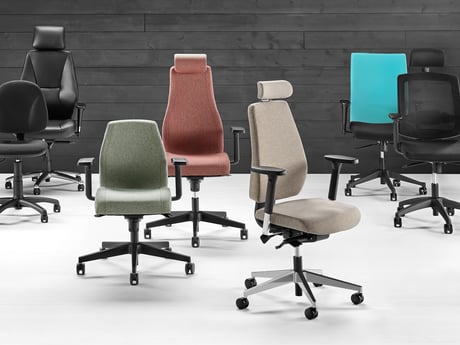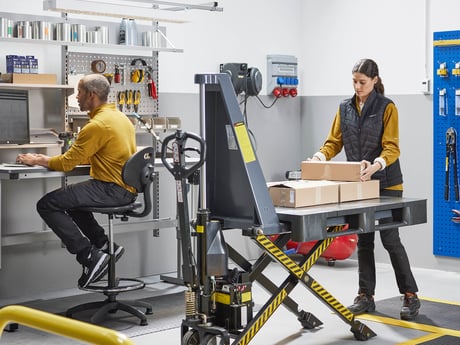
From Research to Reality: Creating an Award-Winning Work Environment
For many of us, the office can be like a second home, considering the amount of time that can be spent at work. It's only natural to think that our workplaces should be designed with the same care and consideration we give to our homes.
In recent years, this understanding - that the office is more than just a place to work, but an integral part of our lives - has started to take hold.
Heléne Lidström, a workplace strategist at Castellum, knows this firsthand. During her time as a Swedish marketing director at a major global IT company, she realised that while technology had dramatically transformed our daily lives, our office environments had not evolved to keep pace.
"Our offices still looked like they did when phones were attached to the wall with a cord!" she reflects.

"The space itself wasn't the issue," Heléne explains. "The problem was that we had 600 employees and 600 desks, even though only 30 percent were ever in use at the same time. We simply hadn’t optimised the space to fit our actual needs."
Variety is the key
When Heléne Lidström suggested a radical redesign of the offices to boost employee well-being and productivity, she initially faced some skepticism and concern. To ensure the best possible outcomes, she grounded her approach in scientific research.
"For this project, I relied heavily on The Healthy Brain Platter," Heléne explains. "This theory suggests that our minds need seven key components to thrive: sleep, physical activity, focus, connection, reflection, play and recovery. Additionally, we conducted a thorough needs analysis to understand our employees’ desires and requirements."
The Healthy Brain Platter, inspired by the classic nutritional food pyramid, was developed by American researchers David Rock and Daniel Siegel. The premise is that good brain health - and a balanced life - requires incorporating these seven types of acticvities on a daily basis. The key is variety - much like how we wouldn’t want to eat the same meal every day.


Sleep, of course, is essential, but for the brain to truly thrive, we also need uninterrupted focus time and the chance to "play" - to explore new experiences with an open mind.
Everyone’s needs are unique and can change over time, which is why, as Daniel Siegel emphasizes, it’s important to incorporate a full range of these activities into each day, even if only briefly.
In an office setting, this could translate to offering different zones tailored to the tasks at hand. Creative meetings often benefit from relaxed and comfortable environments, while focused work is best supported by more secluded spaces.


When designing different zones, it’s important to embrace a variety of materials in each room, such as laminate, different colours and textures, fabrics on furniture and curtains. This approach not only defines the purpose of each zone but also creates a cohesive overall impression, explains Philip Götesson, part of the a project sales team at AJ Products.
He notes that flexibility and variety can be achieved in more ways than just through zoning:
"Meetings often occupy a significant portion of work time, but they vary greatly in size. Most meetings involve 2-4 participants, which calls for smaller meeting rooms. It’s also crucial to have smaller phone rooms or office pods for private calls or video chats, and making sure people can't book these in advance can greatly enhance flexibility."
Philip also highlights the importance of allowing employees to choose their workspace and position based on the task at hand:
"For short-term needs, an acoustic couch or a laptop table might be the ideal workspace," he adds.


"The New Office" becomes an international sensation
The office that Heléne Lidström helped design transformed from a simple setup with just desks and meeting rooms into a dynamic space featuring various zones tailored to different needs. Among these were "The Park," an open green area for a relaxed work environment; "The Library," a quiet space for focused tasks; and "The Sports Bar," equipped with built-in speakers for streaming music. This innovative design quickly gained international attention.
For Heléne and her team, early recognition of their successful redesign came through numerous awards, such as Sweden's Best Workplace and Sweden's Most Stylish Office, along with visits from professionals worldwide.
To gauge the impact of the new office on employee well-being and productivity, the company assessed both employee feedback and performance metrics.
“You're not always going to see a significant boost in both well-being and output, but that was the case here. It was a real success,” Heléne notes.
Since then, The Healthy Mind Platter has remained a core element in all of Heléne Lidström’s projects, driven by the goal of creating sustainable workplaces that optimise both physical and mental well-being.
The 7 Parts of The Healthy Mind Platter
- Sleep: Sleep allows the brain to recover and consolidate the day's learning and experiences.
- Physical Activity: Exercise boosts brain health in multiple ways and also improves sleep.
- Time to Focus: Focusing fully on a task without interruptions helps the brain form deep connections.
- Reflection Time: Quiet reflection on sensory impressions, feelings, and thoughts enhances cooperation between different parts of the brain.
- Connection: Relationships are crucial for both brain health and our overall physical and mental well-being.
- Play: Engaging in spontaneous, creative activities and new experiences helps the brain form new connections, according to Daniel Siegel.
- Recovery: Giving the brain time to relax and allowing the mind to wander helps us "recharge."
Feel Good Factors, from an Ergonomist




